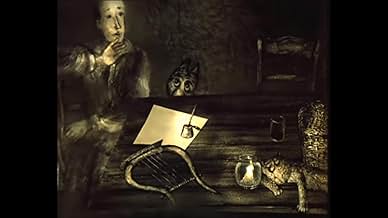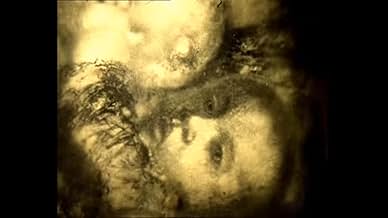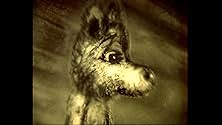Skazka skazok
- 1979
- 29min
CALIFICACIÓN DE IMDb
7.8/10
4.4 k
TU CALIFICACIÓN
Agrega una trama en tu idiomaDistant, well-worn memories of childhood are inhabited by a little gray wolf. Through astonishing imagery, the memory of all of Russia is depicted.Distant, well-worn memories of childhood are inhabited by a little gray wolf. Through astonishing imagery, the memory of all of Russia is depicted.Distant, well-worn memories of childhood are inhabited by a little gray wolf. Through astonishing imagery, the memory of all of Russia is depicted.
- Dirección
- Guionistas
- Elenco
- Premios
- 2 premios ganados en total
- Dirección
- Guionistas
- Todo el elenco y el equipo
- Producción, taquilla y más en IMDbPro
Opiniones destacadas
I admit I didn't really "get" this film. There are probably references to things in Russian history and culture that go over my head. But I admire the effort, style and vision that went into this dreamlike fantasy about childhood and war (I think).
In most people's head the animation film is connected to Disney movies or to Japanese manga animation films, which are very hip nowadays. But everyone seems to overlook Russian animators. The most influential of them is Yuri Norstein, whose timeless masterpiece was awarded at the festival of animation films in Los Angeles in 1984 and at many other film festivals throughout the world. But why is this short half-an-hour movie so beautiful?
Firstly, because Norstein has a matchless visual style. I expected something special after I've read about the film and before I saw it but what I got is something extraordinary: breathtaking pictures, fantastically clever use of mixed media, fine classical music. Secondly, because of the complex, symbol-ridden story, which is rooted in the Russian mythology. The story is about childhood innocence, the loss of the loved ones and the duty of the artist. It's very European, very Eastern-European and because I'm from Hungary and our past is very similar, this animation film is much closer to me than the American or Japanese ones.
Firstly, because Norstein has a matchless visual style. I expected something special after I've read about the film and before I saw it but what I got is something extraordinary: breathtaking pictures, fantastically clever use of mixed media, fine classical music. Secondly, because of the complex, symbol-ridden story, which is rooted in the Russian mythology. The story is about childhood innocence, the loss of the loved ones and the duty of the artist. It's very European, very Eastern-European and because I'm from Hungary and our past is very similar, this animation film is much closer to me than the American or Japanese ones.
10kamerad
I must discuss the Russian Yuri Norstein's stunning "Tale of Tales". Like the films of another great Russian filmmaker, Andrei Tarkovsky, this film is about memory and nostalgia. The uses of various techniques of animation, primarily cutouts, not only let us see Norstein's memories, but also help illustrate their dream-like qualities. There are events in this film that, taken literally, could not have happened. However Norstein represents these memories metaphorically, thereby making their emotional impact greater than were he to simply illustrate his memories in a straight forward narrative.
There are a couple of moments that reflect the above-mentioned statement that I feel I must include in this entry. I loved the scene where the little boy is standing in the snow eating an apple , looking up at some crows on a tree branch. The boy then appears on the branch, buddies up with the crows and shares his apple with them. This is a great, moving, but non-sentimental image that lets us feel the child's desire for friendship. Just after that, his father, whose Napoleon hat identifies him as a tyrant, yanks him out of his daydream. The little boy at first struggles, but then a little Napoleon hat appears on his head and he marches in file behind his dad. This scene reminded me of the Disney WWII era short "Education for Death", in that it also is about childhood innocence being destroyed by adults conditioning their behavior. But where "Education." was a didactic propaganda tool, "Tale of Tales" simply shows how sad and unfortunate it is for adults to do that to children, and illustrates it in such a poetic way.
There are a couple of moments that reflect the above-mentioned statement that I feel I must include in this entry. I loved the scene where the little boy is standing in the snow eating an apple , looking up at some crows on a tree branch. The boy then appears on the branch, buddies up with the crows and shares his apple with them. This is a great, moving, but non-sentimental image that lets us feel the child's desire for friendship. Just after that, his father, whose Napoleon hat identifies him as a tyrant, yanks him out of his daydream. The little boy at first struggles, but then a little Napoleon hat appears on his head and he marches in file behind his dad. This scene reminded me of the Disney WWII era short "Education for Death", in that it also is about childhood innocence being destroyed by adults conditioning their behavior. But where "Education." was a didactic propaganda tool, "Tale of Tales" simply shows how sad and unfortunate it is for adults to do that to children, and illustrates it in such a poetic way.
Not much to add really to what's already been said before, and so well too. Tale of Tales is one of the finest Soviet animations ever made alongside Hedgehog in the Fog, and one of the most powerful and poignant of the entire animation medium too. The visuals are really striking, atmospherically coloured and impeccably detailed, several of the images are enough to stay with you forever and the symbolic ones are really quite meaningful. Tale of Tales is scored wonderfully too, all of it fits with the visuals like strawberries and cream whether ethereally beautiful in the retrospective moments or hauntingly rousing in the war/battle images. The story and atmosphere are rendered adeptly, the story is structured into three sections, each of them is firmly focused and full of emotional impact and they follow and overlap one another with no signs of jarring or clumsiness. The retrospective moments are nostalgic and poignant, the middle section is just gut-wrenching and the idealism of the final section shows some hope, contrasting beautifully with what's been seen before. Tale of Tales is well-paced, it allows the visuals to breathe and resonate nor does it descend into tedium, and the powerful, affecting and nostalgic atmosphere is incredibly well-done. To conclude, a fine example of a Soviet animation masterpiece and one of the finest examples too. 10/10 Bethany Cox
Great film. The scene of child with birds remind me the almost same scenes form Andrei Tarkovsky's "the Mirror". I see this film on DVD(the collection of Russian Animation films), the effect is marvelous! The total film like a dream, sometimes make you feel bitter, sometimes smile with tears. I like the prelude and fuge by Bach in this film, and the tango music is also used in Nikita Mikhalkov's film " Burnt by the Sun". The Great film(not only the animation film) I have ever seen.
¿Sabías que…?
- TriviaThe sound of the baby drinking his milk was actually the sound of a puppy, and the sad eyes of the wolf were copied from a magazine picture of a rescued kitten.
- ConexionesFeatured in Masters of Russian Animation - Volume 3 (2000)
- Bandas sonorasUtomlyonnoe solntse
Written by Jerzy Petersburski
Russian lyrics by Iosif Alvek
Performed by Aleksandr Tsfasman
Selecciones populares
Inicia sesión para calificar y agrega a la lista de videos para obtener recomendaciones personalizadas
Detalles
Taquilla
- Total a nivel mundial
- USD 82,099
Contribuir a esta página
Sugiere una edición o agrega el contenido que falta

Principales brechas de datos
By what name was Skazka skazok (1979) officially released in India in English?
Responda















